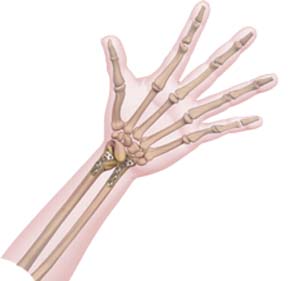What is a Wrist Fracture?
The wrist consists of two bones in the forearm, the radius and ulna, and eight tiny carpal bones in the palm. The bones meet to form multiple large and small joints. A wrist fracture refers to a break in one or more of these bones. The most commonly broken bone involved in a wrist fracture is the Distal Radius.
Types of Wrist Fractures
The types of wrist fracture include:
- Simple wrist fractures, in which the fractured pieces of bone are well aligned and stable.
- Unstable fractures, in which fragments of the broken bone are misaligned and displaced.
- Open (compound) wrist fractures, in which the bone has fractured severely and cut through the skin. This type of fracture is more prone to infection and requires immediate medical attention.

Causes of Wrist Fractures
Wrist fractures may be caused by a fall on an outstretched hand (FOOSH injury), vehicular accidents, or workplace injuries. Contact sports also place individuals at a higher risk for wrist fracture. Wrist fractures are also commonly associated with osteoporosis, a condition marked by brittleness of the bones.
Signs and Symptoms of Wrist Fractures
The common symptoms of a wrist fracture include severe pain, swelling, and limited movement of the hand and wrist. Other symptoms include:
- Deformed or crooked wrist
- Bruising
- Numbness
- Stiffness
Diagnosis of Wrist Fractures
Your doctor will perform a preliminary physical examination followed by imaging tests such as an X-Ray to diagnose a fracture and check the alignment of the bones. Sometimes a CT scan may be ordered to gather more details of the fracture, such as damage to soft tissue, nerves or blood vessels. In some cases, a MRI may also be ordered to identify tiny fractures and ligament injuries.
Treatment for Wrist Fracture
Your doctor may prescribe analgesics and anti-inflammatory medications to relieve pain and inflammation caused by a wrist fracture.
Fractures that are not displaced are treated with either a splint or cast to hold the wrist in place.
If the wrist bones are displaced, your surgeon may perform fracture reduction to align the bones. This is performed typically under local anesthesia. A splint or a cast is then placed to support the wrist and allow healing.
Surgery is recommended to treat severely displaced wrist fractures and is carried out under the effect of general anesthesia. Some of the common surgeries may include:
- Internal fixation may be recommended to maintain the bones in proper position while they heal. Devices such as rods, plates and screws may be implanted at the fracture site.
- External fixation, such as pins, may be used to treat the fracture from the outside. These pins are fixed above and below the fracture site and are held in place by an external frame outside the wrist.
What is Open Reduction and Internal Fixation of the Wrist?
Open reduction and internal fixation (ORIF) of the wrist is a surgical technique employed for the treatment of severe wrist fractures. A plate and screws align the bones and hold them in place to allow for healing.
Procedure for ORIF of the Wrist
Open reduction and internal fixation is the procedure most commonly used to treat displaced distal radius fractures.
The surgery is performed under sterile conditions in the operating room, under general or regional anesthesia.
- After sterilizing the affected area, the surgeon will make an incision around the wrist.
- After carefully visualizing the fracture, the bone fragments are first repositioned (reduced) into their normal alignment.
- The fragments of bone are then held in place with wires, screws, pins, or metal plates attached to the outer surface of the bone.
- After securing the bone, the incisions are closed by suturing or staples and covered with sterile dressings.
Postoperative Care
Pain is common post-surgery and medication is commonly prescribed to help with pain relief. After surgery, the affected wrist will be placed in a splint for support and protection. Patients are instructed to keep their wrist immobile for several weeks to allow bone healing. Most often, patients return the same day with scheduled follow-up appointments for monitoring progress and for stitches or staple removal, if necessary.
Hand therapy is usually initiated after the first postoperative visit to prevent stiffness, strengthen muscles, and restore range of motion.
Throughout treatment, x-rays are performed to ensure proper healing and alignment of the bones. Most people return to their normal activities within a couple of months.
Risks and Complications
As with any surgery, some of the potential risks and complications of open reduction and internal fixation of wrist fractures may include:
- Bleeding
- Swelling
- Infection
- Pain
- Anesthetic complications
- Damage to nerves and blood vessels
- Hardware irritation
- Fracture non-healing
- Broken hardware
- Repeat surgery
